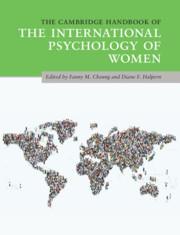Book contents
- The Cambridge Handbook of the International Psychology of Women
- The Cambridge Handbook of the International Psychology of Women
- Copyright page
- Dedication
- Contents
- Figures
- Tables
- Contributors
- Acknowledgments
- Section 1 The Underpinnings of Sex and Gender and How to Study Them
- Section 2 Developmental Perspectives of the International Psychology of Women
- Section 3 Cognitive and Social Factors
- Section 4 Work and Family Issues
- 19 Career Development of Women
- 20 The Psychology of Women in Entrepreneurship
- 21 Women’s Leadership across Cultures
- 22 Occupational Health Psychology and Women in Asian Contexts
- 23 Work–Family Interface and Crossover Effects
- 24 Intimate Relationships
- 25 Contextualizing the Many Faces of Domestic Violence
- Section 5 Inequality and Social Justice
- Section 6 Health and Well-Being
- Epilogue Some Final Thoughts and Take-Home Messages
- Index
- References
24 - Intimate Relationships
from Section 4 - Work and Family Issues
Published online by Cambridge University Press: 20 July 2020
- The Cambridge Handbook of the International Psychology of Women
- The Cambridge Handbook of the International Psychology of Women
- Copyright page
- Dedication
- Contents
- Figures
- Tables
- Contributors
- Acknowledgments
- Section 1 The Underpinnings of Sex and Gender and How to Study Them
- Section 2 Developmental Perspectives of the International Psychology of Women
- Section 3 Cognitive and Social Factors
- Section 4 Work and Family Issues
- 19 Career Development of Women
- 20 The Psychology of Women in Entrepreneurship
- 21 Women’s Leadership across Cultures
- 22 Occupational Health Psychology and Women in Asian Contexts
- 23 Work–Family Interface and Crossover Effects
- 24 Intimate Relationships
- 25 Contextualizing the Many Faces of Domestic Violence
- Section 5 Inequality and Social Justice
- Section 6 Health and Well-Being
- Epilogue Some Final Thoughts and Take-Home Messages
- Index
- References
Summary
Intimate relationships exist around the world, throughout the lifespan, and are influential in every domain of peoples’ lives. This chapter provides a brief review of the literature on intimate dating and marital relationships including processes such as attraction and relationship initiation, relationship maintenance, and relationship dissolution. A few theoretical perspectives (evolutionary, interdependence, attachment, self-expansion) are highlighted throughout the chapter. A main focus of this review is discussing intimate relationships in the context of gender and culture, including limitations in our current knowledge and suggestions for future research.
Keywords
- Type
- Chapter
- Information
- The Cambridge Handbook of the International Psychology of Women , pp. 342 - 354Publisher: Cambridge University PressPrint publication year: 2020
References
Suggested Readings

Ahva Mozafari is a doctoral candidate in the Clinical Psychology program at Idaho State University. She received her BSc in Psychology from Boise State University and her MSc in Clinical Psychology from Eastern Washington University. Her research interests include romantic relationships, shame, attachment, and culture. A large portion of her clinical work has been in community mental health with refugees as well as with US-born adults, children, and adolescents. She has also worked with couples and families. Mozafari was born and grew up in Boise, Idaho. Her parents are immigrants from Iran, and she has spent several summers there throughout her life. She identifies as a first generation Iranian American.

Xiaomeng (Mona) Xu is an Associate Professor of Experimental Psychology at Idaho State University. She received her BA in Psychology from New York University and her MA in Psychology and PhD in Social Health Psychology from Stony Brook University, and she completed a postdoctoral Research Fellowship sponsored by the National Institutes of Health at the Warren Alpert Medical School of Brown University and the Miriam Hospital. Xu and her lab conduct both basic and applied research on romantic relationships, behavioral health, neuroimaging, and pedagogy. She was born in Fuling, a district of Chongqing Municipality in China and grew up in the United States. She conducted collaborative research in Bejing. She identifies as an immigrant.



